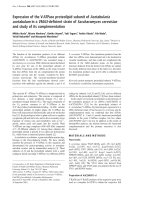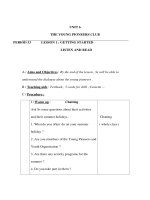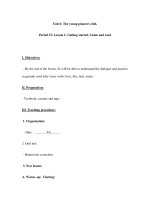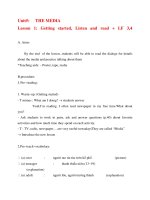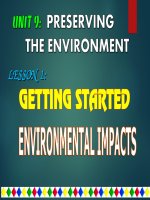skkn cấp tỉnh raising the students awareness about protecting the enviroment by integrating knowledge of many subjects in teaching lesson 1 getting started unit 5 global warming of english 11
Bạn đang xem bản rút gọn của tài liệu. Xem và tải ngay bản đầy đủ của tài liệu tại đây (2.1 MB, 20 trang )
<span class="text_page_counter">Trang 1</span><div class="page_container" data-page="1">
Thach Thanh 4 high school Nguyen Thi Thuong Huyen
A list of the research has been rated by the board of examiners of Thanh HoaDepartment of Education education and training, which is ranked from the C
levelAuthor: Nguyen Thi Thuong Huyen
Office : Teacher at Thach Thanh 4 High School
Number Name of the research Assessed by Result Schoolyear1 Some methods to teach the
reading skills in national high school exam for the 12<small>th</small> grade students at Thach Thanh 4 High School
Department ofEducation andTraining.
2 Integrating knowledge of many subjects in teaching partc-Listening unit 8: Life in the
Department ofEducation andTraining.
I. INTRODUCTION1.Reasons for research
2.Purposes 3.Subjects
II. CONTENTS
3.Solutions : Positive teaching techniques by using
integrated History, Biography, Civic education, Literature, Music and life skills in teaching Part b- speaking Unit 10: Nature in danger
III.CONCLUSION1.General conclusion
2.Recommendation
</div><span class="text_page_counter">Trang 2</span><div class="page_container" data-page="2">Thach Thanh 4 high school Nguyen Thi Thuong Huyenfuture,English 12
3 Integrating knowledge of many subjects in teaching partB-Listening unit 10: Nature in danger,English 10
Department ofEducation andTraining.
</div><span class="text_page_counter">Trang 3</span><div class="page_container" data-page="3">I. INTRODUCTION
<b>1. Reasons for the research </b>
Raising student's awareness about global warming is essential for cultivating ageneration committed to environmental protection. By researching students canunderstand the severe impact of human activities on your planet.This knowledgehighlights the urgency of addressing climate change, inspires students to thinkcritically about their lifestyle choices, promotes eco-friendly behaviors them toadvocate for necessary policy changes. By educating young minds on this issuefosters a sense of responsibility and urgency, motivating them to take action in their communities and beyond.Ultimately, informed students are more likely tocontribute to a sustainable future, making research on global warming a vitalcomponent of environmental education.
<b>2. Purpose.</b>
Understanding global warming helps students comprehend the profound impacthuman activities have on the planet. This knowledge fosters a sense of urgencyand responsibility, encouraging them to adopt sustainable practices and makeeco-friendly choices.By exploring the causes and consequences,students becomemore informed,empowered to advocate for environmental policies andinitiatives.
Educating students on this critical issue prepares them to be proactive stewards of the environmental, capable of contributing to a sustainable future.Ultimately,raising awareness through research equips students with tools and knowledgeneeded to address and combat climate change effectively.
Based on the innovation of the teaching positive methods of the Ministry ofEducation and Training,I would like to give some experiences in teaching lesson1: Getting Started, Unit 5: Global Warming, English 11(Global Success)
<b> 3.Subjects.</b>
Subjects for researching global warming should include the science behindclimate change, its causes, and its effects on ecosystems and human life. Topicssuch as greenhouse gas emissions, deforestation, and fossil fuel consumption arecrucial for understanding the problem's roots. Additionally, studying the impact of global warming on weather pattern,sea levels and biodiversity helps studentsgrasp the severity of the issue.Solutions and mitigation strategies such as theseverity of issue.Solutions and mitigation strategies,such as renewable energy,conservation efforts and sustainable practices should also be covered.Throughthese subjects, students can gain the comprehensive understanding of globalwarming, empowering them to make informed decisions and take proactivesteps towards environmental protection
<b>4.Methods</b>
</div><span class="text_page_counter">Trang 4</span><div class="page_container" data-page="4">The teacher should include the combination of scientific inquiry and practicalactivities. Students can start reviewing current scientific literature and credibleonline resources to understand the basics of climate science. From conductingexperiments, such as measuring carbon dioxide levels or observing the effectsof temperature changes on plants, can provide hands-on learning experiences.Organizing field trips to local ecosystems or renewable energy facilities can offer-world insights. Additionally, engaging in discussions and debates onClimate policies and their impacts can help students develop critical thinking skills. Incorporating multimedia resources,such as documentaries, interactivesimulations, can also make learning about global warming more engaging andeffective. These methods collectively help them grasp the significance of theIssue and inspire them to take action.
From this method, it helps students know the most self-taught method, the way to present and evaluate the other group’s knowledge. Asking students to useIntegrating knowledge of many subjects in teaching lesson 1:Getting Started, Unit 5:Global Warming , English 11( Global Success).
<b>Theoretical background </b>
Global warming, a critical aspect of environmental science, refers to the term rise in Earth's average temperature due to human activities, particularly the emission of greenhouse gases like carbon dioxide and methane. Theoretical background on this topic is essential to raise students' awareness about its profound impact on the environment. Understanding the greenhouse effect, where these gases trap heat in the atmosphere, is fundamental. Moreover,
long-exploring the consequences such as melting polar ice caps, rising sea levels, and increased frequency of extreme weather events helps students grasp the urgency of the issue. Education should also cover the role of deforestation and fossil fuel consumption in exacerbating global warming. By integrating this knowledge into their curriculum, students can develop a deeper awareness and a sense of responsibility towards adopting sustainable practices and supporting policies aimed at mitigating climate change.
<b>2.Realities before applying the research</b>
With the lesson 1 in unit 5, I used to teach the students by teaching positivemethod that follows.
Homework checking
I. Lead in the lesson & vocabulary
<i><b>- Ask some students to answer some questions in the textbook</b></i>
- Ask ss provide some new words/ expressions that appear in reading text whichis prepared before going class.
II. Practice:
<i>- Ask ss to do all the tasks ( in textbook): matching & filling the blanks.</i>
</div><span class="text_page_counter">Trang 5</span><div class="page_container" data-page="5">- Ask sts to talk about global warming
- Give homework: Write a short paragraph about global warming.
Global warming is the gradual increase in Earth's average surface temperature,primarily caused by human activities that release greenhouse gases like carbondioxide and methane into the atmosphere.These gases trap heat, a “greenhouse effect” that leads to rise temperatures.The consequences of global warming arefar-reaching and severe, including more frequent and intense heatwaves, meltingglaciers, polar ice caps, rising sea levels and disrupted weather patterns, whichcan lead to extreme events like hurricanes and droughts. Additionally, globalwarming poses significant threats to biodiversity, as many species struggle to adapt to rapidly changing climate. Addressing global warming requires urgentand collective action, such as reducing carbon emissions, transitioning to energysources, implementing sustainable practices. Raising awareness and educatingthe public. Impacts of global warming is crucial for fostering a generation toprotecting our planet.
In my research, I mention the new ways in teaching lesson 1: Getting Started,Unit 5: Global Warming, English 11(Global Success) effective by teachingpositive methods in it. I would like to present the form of teaching plan below.
<b>Warm - up (Teacher asks each group to prepare one part at home)</b>
Students 1 show the pictures of global warming which are asked to prepare at home
- Burning the forest
- Discharging pollutants into environment from factories and vehicles.- Climate change: flood, drought, tsunami
<i>-> Our earth is being threatened seriously</i>
Teacher pays attention carefully student in group 1’s presentation and explainmore information if it is necessary.Students give answer: It is global warming
<b>T leads students to the new lesson:</b>
</div><span class="text_page_counter">Trang 6</span><div class="page_container" data-page="6"><i> “To know more about the causes and consequences the global warming and measures to protect the earth ,let’s learn the new lesson”</i>
Teacher checks the student’s answer
<i>Group 2 gives the correct name of the pictures : That’s why these trapping pollutants are known as greenhouse gases,and their impact is called the greenhouse effect</i>
heat-+ Heat /hiːt/ : nhiệt heat-+ Trapping/træping/: nhốt,giữ + Pollutant /pəˈluː.t̬ənt/ : chất ô nhiễm
<b>2.</b> Heat Trapping Pollutant : giữ nhiệt chất gây ô nhiễm
Ask students in group 1,3,4 to pay attention pictures and ask “What is the
<i>phenomenon in pictures? and What happened to the earth?”</i>
</div><span class="text_page_counter">Trang 7</span><div class="page_container" data-page="7">Group 1,3,4 guess the meaning
<i>Group 2 gives the correct answer with the pictures: +They are greenhouse gases.</i>
<i>What does the phrase word “greenhouse gases” mean?</i>
<i>3. Greenhouse gases/ˌɡriːn.haʊs ˈɡæsiz/ : khí nhà kính</i>
<i>Group 2 shows the other pictures and asks “What can you guess in these pictures?” </i>
Group 1,3,4 answer the question of the pictures
+ They are human activities which these gases are mainly produced throughGive the answer with the pictures:
4. Human activities : /ˈhjuː.mən /ækˈtɪv.ə.t̬iz/ : hoạt động của con ngườiTeacher asks all students to listen carefully and explain more if it is wrongGroup 2 asks students in group 1,3,4 to look at the pictures and guesses <i>“What can you guess for these following pictures?</i>
Group 2 suggests about paying attention and guess the word in Vietnamese “mực nước biển”
<i>Group 2 gives the name of the pictures: They are rising sea levels </i>
<i>What does it mean? </i>
</div><span class="text_page_counter">Trang 8</span><div class="page_container" data-page="8">5. <i>Sea levels /ˈsiː ˌlev.əl/: mực nước biển</i>
Teacher shows all words or phrases, then asks students to look at the board and listens to the teacher first
1. Global warming : /ˌɡloʊ.bəl ˈwɔːr.mɪŋ/: sự nóng lên tồn cầu2. Heat trapping pollutant : giữ nhiệt chất gây ô nhiễm
<i>3. Greenhouse gases : /ˌɡriːn.haʊs ˈɡỉsiz/: khí nhà kính</i>
4. Human activities : /ˈhjuː.mən /ỉkˈtɪv.ə.t̬iz/: hoạt động của con người5. Sea levels : /ˈsiː ˌlev.əl/: mực nước biển
Teacher asks all students to write down on their notebook, then read after the teacher
Teacher calls 1,2,students read the words again, then check pronunciationStudents listen then copy down in their notebook and read after teacher then read individual
CHECKING VOCABULARY
Teacher uses the vocabulary checking to review the vocabulary for them
<b>Ask students to match word in A with its meaning in B in the textbook(task </b>
3-page 53).Teacher checks student’s answer and give the correct
<b>1.c 2. e 3.b 4.a 5.d</b>
PRACTICES
Task 4: Brainstorming ( books closed)
Student in group 3 says out their ideas about some reasons why global warmingis serious in their group first, then calls on group 1,2,4 to say out their answers.Group 3 notes down group 1,2,4’ ideas on the board
<i>+ Cutting down the tree for farming…………..</i>
Group 3 shows on the screen this model below for students to follow and asks them to work in pair in each group
Group 3 listens to their answer, shows some pictures then contribute the effectsof global warming
</div><span class="text_page_counter">Trang 9</span><div class="page_container" data-page="9">
Group 1,2,4 pay attention to the pictures to answer .+ Slowing climate change reverse drying the subtropical
<i>-> Changing rainfall patterns expansion of desert in the subtropical</i>
<i>-> More flooding in coastal areas</i>
Teacher shows the pictures and gives out one of the other effects of global warming
Group 1,2,4 look at the pictures and can answer
</div><span class="text_page_counter">Trang 10</span><div class="page_container" data-page="10">Group 3 asks: Do you know phenomenon in pictures?Give more information
<i>->Antarctica is losing ice mass (melting) at an average rate of about 150 billion </i>
tons per year, and Greenland is losing about 270 billion tons per year, adding to sea level rise.
Teacher instructs student can accord geographical knowledge, students can givesome information.
Group 3 shows the map about African lions, endangering their survival because of global warming , then ask ss to comment
Group 1,2,4 gives comment Global warming poses a significant threat to African lions, endangering their survival
<i>->As temperatures rise, their habitats shrink, and prey becomes scarce, </i>
increasing the risk of extinction for these majestic animals. Urgent action is needed to mitigate climate change and protect these iconic predators.
<i>Group 3 gives the pictures, then asks students “Do you know about the causes extinction of some animals?”</i>
Group 1,2,4 based on the biography, students can give answer in Vietnamese
<i> -> Because of global warming ,355 plant species and 365 animal species are </i>
now under threat. Vietnamese ecosystems, such as the tropical forest, are both diverse and fragile and will easily deteriorate with irregular climate fluctuations.
<i>Teacher asks group 3 to give name some consequences of cutting the trees for farming which is causing global warming? </i>
</div><span class="text_page_counter">Trang 11</span><div class="page_container" data-page="11"><i> </i>
Group 3 answers that Cutting down trees is killing ourselves
Teacher shows some pictures of natural disaster which has happened to people in recently years to ask all class to work in group
<b><small>Hoa binh province </small></b>
One member in group 3 presents : A greenhouse gas is a gas in an atmosphere
<i>that absorbs and emits radiant energy within the thermal infrared range. The primary greenhouse gases in Earth's atmosphere are water </i>
<i>vapor, carbondioxide, methane, nitrous oxide, and ozone, consequently, the more the earth heats. This increase in heat is called the greenhouse effect. </i>
</div><span class="text_page_counter">Trang 12</span><div class="page_container" data-page="12">Teacher and all groups listen carefully about this information,then teacher checks again
Group 1 presents about what are the results of global warming? and asks all group to add information if necessary
<i>-> Over 130 years, the earth's temperature has increased by 0.4 degree</i>
Present two pictures and ask:
<i>What and where is ozone layer?</i>
Based on geography, students in group 1,2,4 can answer:
The earth's atmosphere is divided into several layers, and each layer plays an important role.
<i><b>-> The member of group 3 presents :the ozone layer or ozone shield is a region </b></i>
<i>of Earth's stratosphere that absorbs most of the Sun's ultraviolet (UV) radiation.It contains high concentrations of ozone (O3) in relation to other parts of the atmosphere, although still small in relation to other gases in the stratosphereTeacher only pays attention and explain again for all students to understand clearly</i>
Group 3 shows the pictures about using fertilizers and pesticides for cultivationThis is one of the reasons why global warming is.
Group 3 asks “What are they doing”? and suggested answer:
<i>->They are using fertilizers and pesticides for cultivation</i>
Group 3 presents the pictures and ask : <i>Do they use pesticides regularly?</i>
</div><span class="text_page_counter">Trang 13</span><div class="page_container" data-page="13">Have some information :
<i>->94% of households using pesticides did not follow the instructions on the package, 35% of pesticide users do not read labels </i>
Then ask : What are the harmful effects of using pesticides in global warming?Group 3 gives the disadvantages of using fertilizers and pesticides for global warming<small> </small>
Group 3 gives all reasons why global warming is serious
->Fertilizers are formulated from petroleum-based ingredients and release powerful greenhouse gases, such as methane and nitrous oxide, into the atmosphere when used on fields and farms. These gases help trap heat in the atmosphere, contribute to global warming
Group 3 shows the pictures and asks <i>“What we should do to decrease the global warming?”</i>
The members of group give answers:1. Change a light
2. Drive less. …
3. Recycle more. 4. Check your tires.
5. Use less hot water.
6. Avoid products with a lot of packaging. ...7. Adjust your thermostat.
8. Plant a tree
Group 3 shows the picture and checks again information
</div>